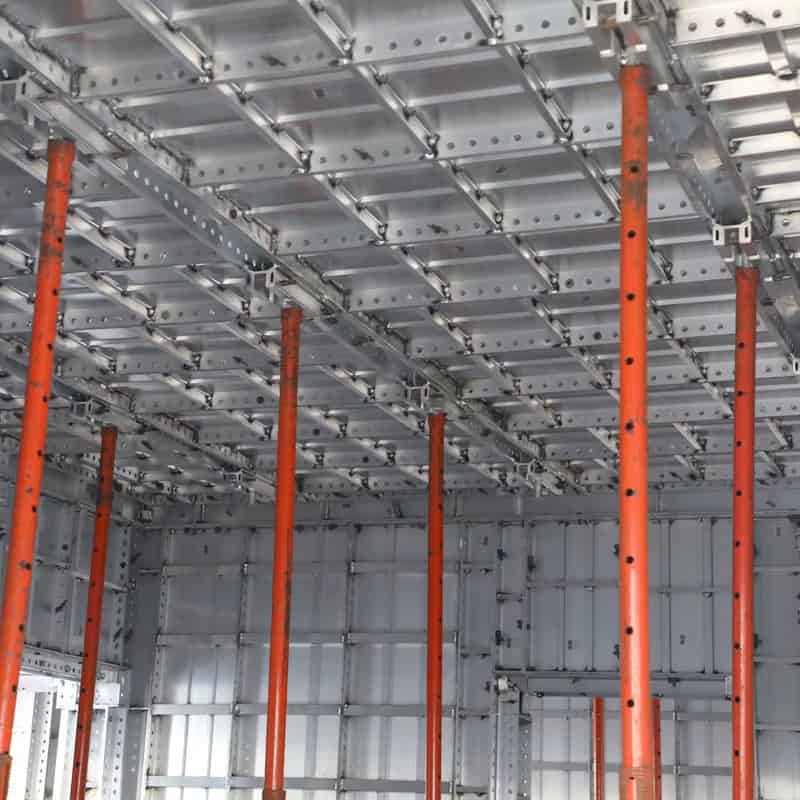Why Is Re-Prop Formwork Used?

Facing delays in construction? Re-prop formwork ensures structural stability and reduces downtime by supporting partially cured concrete, enabling simultaneous construction activities for enhanced efficiency and safety.
Re-prop formwork provides temporary support to partially cured concrete, allowing early removal of the primary formwork. This process speeds up construction, maintains stability, and facilitates overlapping activities in multi-story projects.
Below, we explore the purpose, benefits, applications, and materials of re-prop formwork, along with the concepts of propping systems and their importance in modern construction.
What Is Re-Prop Formwork, and How Does It Work?
Curious about re-prop formwork? This innovative system provides secondary support for partially cured concrete, ensuring stability while allowing early removal of primary formwork for continued construction activities.
Re-prop formwork is a temporary structure that supports concrete after the primary formwork is removed. It allows simultaneous construction on upper levels while ensuring the stability of the lower structure.
Re-prop formwork is used to provide secondary support to concrete that has gained partial strength but requires additional curing time to reach full load-bearing capacity.
- Function: Ensures stability for the lower levels while construction proceeds on the upper levels.
- Design: Typically consists of adjustable props, beams, and bracing.
- Process: After removing the main formwork, re-props are installed to sustain the structure during curing.
This approach accelerates construction timelines without compromising safety or structural integrity.
What Is a Propping System, and Why Is It Important?
Wondering about propping systems? These systems stabilize and support concrete structures during construction, reducing risks of collapse and enabling efficient progress across multi-level projects.
A propping system provides temporary support to structures during construction or renovation. It prevents instability, reduces safety risks, and facilitates overlapping tasks for faster project completion.
A propping system is a temporary structural support mechanism used in construction to:
- Provide Stability: Prevents collapse during construction or renovation.
- Enhance Safety: Protects workers and the structure from failure risks.
- Facilitate Overlapping Tasks: Enables simultaneous construction activities on multiple levels.
- Improve Efficiency: Reduces delays by maintaining stability during critical phases.
Commonly used in multi-story buildings, bridges, and large-scale industrial projects, propping systems are integral to modern construction.
What Does Propping Mean in Construction?
Confused about propping? In construction, it refers to the use of temporary supports to stabilize structures, ensuring safety and progress during critical phases of building or renovation.
Propping in construction involves using temporary supports like steel props, jacks, or braces to stabilize structures during curing or while performing structural modifications. It’s essential for safety and efficiency.
Propping is the process of providing temporary support to a structure during its construction or modification. Key aspects include:
- Purpose: Ensures stability and prevents collapse.
- Materials: Steel props, timber shores, or aluminium systems.
- Applications: Used in concrete curing, beam replacements, and renovations.
Propping is a critical component of safe and efficient construction, especially in projects involving structural changes or multi-level designs.
What Are the Benefits of Using Re-Prop Formwork?
Want to improve efficiency? Re-prop formwork speeds up construction by enabling overlapping activities, reducing project timelines, and ensuring stability during multi-story building processes.
The key benefits of re-prop formwork include faster construction, enhanced safety, reduced material costs, and efficient use of resources. It is especially useful for multi-story and large-scale projects.
The advantages of re-prop formwork are:
- Faster Construction: Allows work on upper levels while lower levels cure.
- Cost Efficiency: Reduces material requirements by reusing primary formwork.
- Safety: Stabilizes structures during the curing phase, reducing risks.
- Resource Optimization: Enables simultaneous construction activities, improving resource allocation.
- Sustainability: Minimizes waste by extending the life of primary formwork.
These benefits make re-prop formwork a valuable tool for modern construction projects.
Where Is Re-Prop Formwork Commonly Used?
Wondering where re-prop formwork fits best? It’s widely used in multi-story buildings, bridges, and large-scale projects that demand efficient use of time and resources.
Re-prop formwork is ideal for multi-story buildings, high-rise construction, bridges, and other projects requiring fast turnaround and overlapping construction processes. It ensures stability and efficiency in challenging conditions.
Re-prop formwork is commonly used in:
- Multi-Story Buildings: Enables simultaneous work on multiple levels.
- Bridges: Supports large spans while concrete gains full strength.
- High-Rise Construction: Reduces construction time by reusing formwork.
- Industrial Projects: Offers stability for large-scale concrete pours.
Its adaptability makes it indispensable for projects requiring speed and structural integrity.
What Materials Are Used in Re-Prop Formwork Systems?
Concerned about durability? Re-prop formwork systems use high-quality materials like steel and aluminium to provide robust and reusable solutions for supporting concrete structures during curing.
Common materials for re-prop formwork include steel for strength, aluminium for lightweight versatility, and timber or plastic for supplementary panels. These materials ensure durability and cost-effective reusability.
The materials used in re-prop formwork systems are:
- Steel Props: Provide high load-bearing capacity and durability.
- Aluminium Beams: Lightweight and corrosion-resistant, ideal for easy handling.
- Timber/Plywood Panels: Used as supplementary molds for specific areas.
- Plastic Components: Occasionally used for lightweight and modular designs.
These materials combine strength, flexibility, and cost-efficiency for optimal performance.
Conclusion
Re-prop formwork and propping systems are vital in modern construction, offering structural stability, safety, and efficiency. Their adaptability makes them essential for multi-level buildings, bridges, and large-scale projects.
